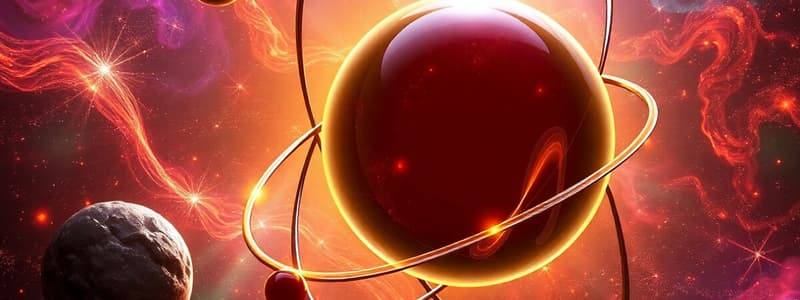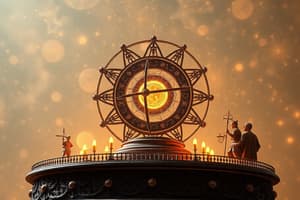Podcast
Questions and Answers
What cannot occur during a chemical reaction according to atomic theory?
What cannot occur during a chemical reaction according to atomic theory?
- Atoms can change into atoms of a different element. (correct)
- Atoms of one element can be destroyed.
- Atoms can be created.
- Atoms can be rearranged.
Which model of the atom was developed by Thomson?
Which model of the atom was developed by Thomson?
- Nuclear model
- Electron cloud model
- Solid sphere model
- Plum Pudding model (correct)
Who is credited with proposing the atomic theory that viewed atoms as solid spheres?
Who is credited with proposing the atomic theory that viewed atoms as solid spheres?
- Bohr
- Thomson
- Dalton (correct)
- Rutherford
What was discovered about the atom by Rutherford?
What was discovered about the atom by Rutherford?
What did Bohr contribute to atomic theory?
What did Bohr contribute to atomic theory?
Which statement is true regarding the composition of compounds?
Which statement is true regarding the composition of compounds?
What is a key feature of atomic reactions according to Dalton's atomic theory?
What is a key feature of atomic reactions according to Dalton's atomic theory?
What was the main flaw in Dalton's theory that was later addressed by Thomson?
What was the main flaw in Dalton's theory that was later addressed by Thomson?
What does Dalton's Atomic Theory state about atoms in chemical reactions?
What does Dalton's Atomic Theory state about atoms in chemical reactions?
According to Dalton's Atomic Theory, what is true about elements?
According to Dalton's Atomic Theory, what is true about elements?
How were compounds described in Dalton's Atomic Theory?
How were compounds described in Dalton's Atomic Theory?
What is the primary concept of the electron cloud model proposed by Schrodinger?
What is the primary concept of the electron cloud model proposed by Schrodinger?
What distinguishes atoms of one element from atoms of another according to Dalton's Atomic Theory?
What distinguishes atoms of one element from atoms of another according to Dalton's Atomic Theory?
Which statement best describes the nature of atoms in Dalton’s Atomic Theory?
Which statement best describes the nature of atoms in Dalton’s Atomic Theory?
In Dalton's model, what is true about the atoms of a given element?
In Dalton's model, what is true about the atoms of a given element?
Which principle is NOT part of Dalton's Atomic Theory?
Which principle is NOT part of Dalton's Atomic Theory?
Which atomic model introduced the concept of a positively charged sphere with embedded electrons?
Which atomic model introduced the concept of a positively charged sphere with embedded electrons?
What does Rutherford's Nuclear Model propose about the structure of the atom?
What does Rutherford's Nuclear Model propose about the structure of the atom?
Which atomic model is characterized by the idea that electrons exist in probabilities within an 'electron cloud'?
Which atomic model is characterized by the idea that electrons exist in probabilities within an 'electron cloud'?
Which of the following atomic models was proposed first in history?
Which of the following atomic models was proposed first in history?
What key feature distinguishes Bohr's Planetary Model from earlier atomic models?
What key feature distinguishes Bohr's Planetary Model from earlier atomic models?
In Dalton's Atomic Theory, what is not proposed about atoms?
In Dalton's Atomic Theory, what is not proposed about atoms?
Which atomic model was developed last among the ones listed?
Which atomic model was developed last among the ones listed?
What is a primary limitation of Dalton's Atomic Theory?
What is a primary limitation of Dalton's Atomic Theory?
According to Rutherford’s experiments, what was discovered about the nucleus of an atom?
According to Rutherford’s experiments, what was discovered about the nucleus of an atom?
What is the definition of an element?
What is the definition of an element?
Which particles are found in the nucleus of an atom?
Which particles are found in the nucleus of an atom?
What comprises the atom's structure?
What comprises the atom's structure?
Which particle is not present in the nucleus of an atom?
Which particle is not present in the nucleus of an atom?
What is the relationship between protons, neutrons, and electrons in an atom?
What is the relationship between protons, neutrons, and electrons in an atom?
How does the number of protons in an atom affect its identity?
How does the number of protons in an atom affect its identity?
Which statement about electrons is correct?
Which statement about electrons is correct?
What role do neutrons play in an atom?
What role do neutrons play in an atom?
What can change an atom into a different element?
What can change an atom into a different element?
What is found outside of the nucleus of an atom?
What is found outside of the nucleus of an atom?
What does the periodic table represent in chemistry?
What does the periodic table represent in chemistry?
Which of the following statements about electronic structure of atoms is true?
Which of the following statements about electronic structure of atoms is true?
What is the significance of the Russian scientist mentioned in the context of chemistry?
What is the significance of the Russian scientist mentioned in the context of chemistry?
Why is the periodic table important for predicting element behavior?
Why is the periodic table important for predicting element behavior?
How are elements arranged in the periodic table?
How are elements arranged in the periodic table?
What defines an atom's electronic structure?
What defines an atom's electronic structure?
What can be inferred about elements in the same group on the periodic table?
What can be inferred about elements in the same group on the periodic table?
Which statement is incorrect regarding the periodic table?
Which statement is incorrect regarding the periodic table?
What are isotopes?
What are isotopes?
Which statement about protons and neutrons is true?
Which statement about protons and neutrons is true?
Why is the mass of an electron often ignored?
Why is the mass of an electron often ignored?
Which particles are known to have a charge?
Which particles are known to have a charge?
What characterizes the mass of protons and neutrons?
What characterizes the mass of protons and neutrons?
How does an atom's size relate to its subatomic particles?
How does an atom's size relate to its subatomic particles?
What effect do protons have in an atom?
What effect do protons have in an atom?
In terms of charge, what is unique about neutrons?
In terms of charge, what is unique about neutrons?
What is primarily responsible for an atom’s mass?
What is primarily responsible for an atom’s mass?
During which phenomenon were negative particles discovered?
During which phenomenon were negative particles discovered?
What term is often used to describe the components of an atom?
What term is often used to describe the components of an atom?
Which of the following correctly states the relationship between neutrons and the atomic mass?
Which of the following correctly states the relationship between neutrons and the atomic mass?
Which particle is considered the lightest in terms of mass?
Which particle is considered the lightest in terms of mass?
Flashcards
Dalton's Atomic Theory
Dalton's Atomic Theory
A model of the atom that depicts it as a solid, indivisible sphere.
Thomson's Plum Pudding Model
Thomson's Plum Pudding Model
A model of the atom that proposes a positively charged sphere with negatively charged electrons embedded in it, like plums in a pudding.
Rutherford's Nuclear Model
Rutherford's Nuclear Model
A model of the atom that suggests a small, dense, positively charged nucleus at the center, surrounded by negatively charged electrons orbiting it.
Bohr's Planetary Model
Bohr's Planetary Model
Signup and view all the flashcards
Schrodinger's Electron Cloud Model
Schrodinger's Electron Cloud Model
Signup and view all the flashcards
Law of Conservation of Matter
Law of Conservation of Matter
Signup and view all the flashcards
Compound
Compound
Signup and view all the flashcards
John Dalton
John Dalton
Signup and view all the flashcards
J.J. Thomson
J.J. Thomson
Signup and view all the flashcards
Ernest Rutherford
Ernest Rutherford
Signup and view all the flashcards
Niels Bohr
Niels Bohr
Signup and view all the flashcards
Electron Cloud Model
Electron Cloud Model
Signup and view all the flashcards
What is Dalton's Atomic Theory?
What is Dalton's Atomic Theory?
Signup and view all the flashcards
Dalton's Atomic Theory: Identical Atoms
Dalton's Atomic Theory: Identical Atoms
Signup and view all the flashcards
Dalton's Atomic Theory: Conservation of Atoms
Dalton's Atomic Theory: Conservation of Atoms
Signup and view all the flashcards
Dalton's Atomic Theory: Building Compounds
Dalton's Atomic Theory: Building Compounds
Signup and view all the flashcards
Dalton's Atomic Theory: Basic Building Blocks
Dalton's Atomic Theory: Basic Building Blocks
Signup and view all the flashcards
Dalton's Atomic Theory: Element Differences
Dalton's Atomic Theory: Element Differences
Signup and view all the flashcards
What is the Electron Cloud Model?
What is the Electron Cloud Model?
Signup and view all the flashcards
Schrödinger's Role in the Electron Cloud Model
Schrödinger's Role in the Electron Cloud Model
Signup and view all the flashcards
What are atoms?
What are atoms?
Signup and view all the flashcards
What are elements?
What are elements?
Signup and view all the flashcards
What are protons?
What are protons?
Signup and view all the flashcards
What are neutrons?
What are neutrons?
Signup and view all the flashcards
What are electrons?
What are electrons?
Signup and view all the flashcards
What is the atomic number?
What is the atomic number?
Signup and view all the flashcards
What is the atomic mass?
What is the atomic mass?
Signup and view all the flashcards
What are isotopes?
What are isotopes?
Signup and view all the flashcards
What is the nucleus?
What is the nucleus?
Signup and view all the flashcards
What are electron shells?
What are electron shells?
Signup and view all the flashcards
What is the Periodic Table?
What is the Periodic Table?
Signup and view all the flashcards
What are element symbols?
What are element symbols?
Signup and view all the flashcards
What are periods in the periodic table?
What are periods in the periodic table?
Signup and view all the flashcards
What are groups in the periodic table?
What are groups in the periodic table?
Signup and view all the flashcards
What are metals on the periodic table?
What are metals on the periodic table?
Signup and view all the flashcards
What are nonmetals on the periodic table?
What are nonmetals on the periodic table?
Signup and view all the flashcards
What is the mass number?
What is the mass number?
Signup and view all the flashcards
What is electronegativity?
What is electronegativity?
Signup and view all the flashcards
What is an atom?
What is an atom?
Signup and view all the flashcards
What is the tendency of an atom to gain or lose electrons?
What is the tendency of an atom to gain or lose electrons?
Signup and view all the flashcards
What are strong nuclear forces?
What are strong nuclear forces?
Signup and view all the flashcards
What is electron configuration?
What is electron configuration?
Signup and view all the flashcards
What is an orbital?
What is an orbital?
Signup and view all the flashcards
What is ionization?
What is ionization?
Signup and view all the flashcards
What is a molecule?
What is a molecule?
Signup and view all the flashcards




